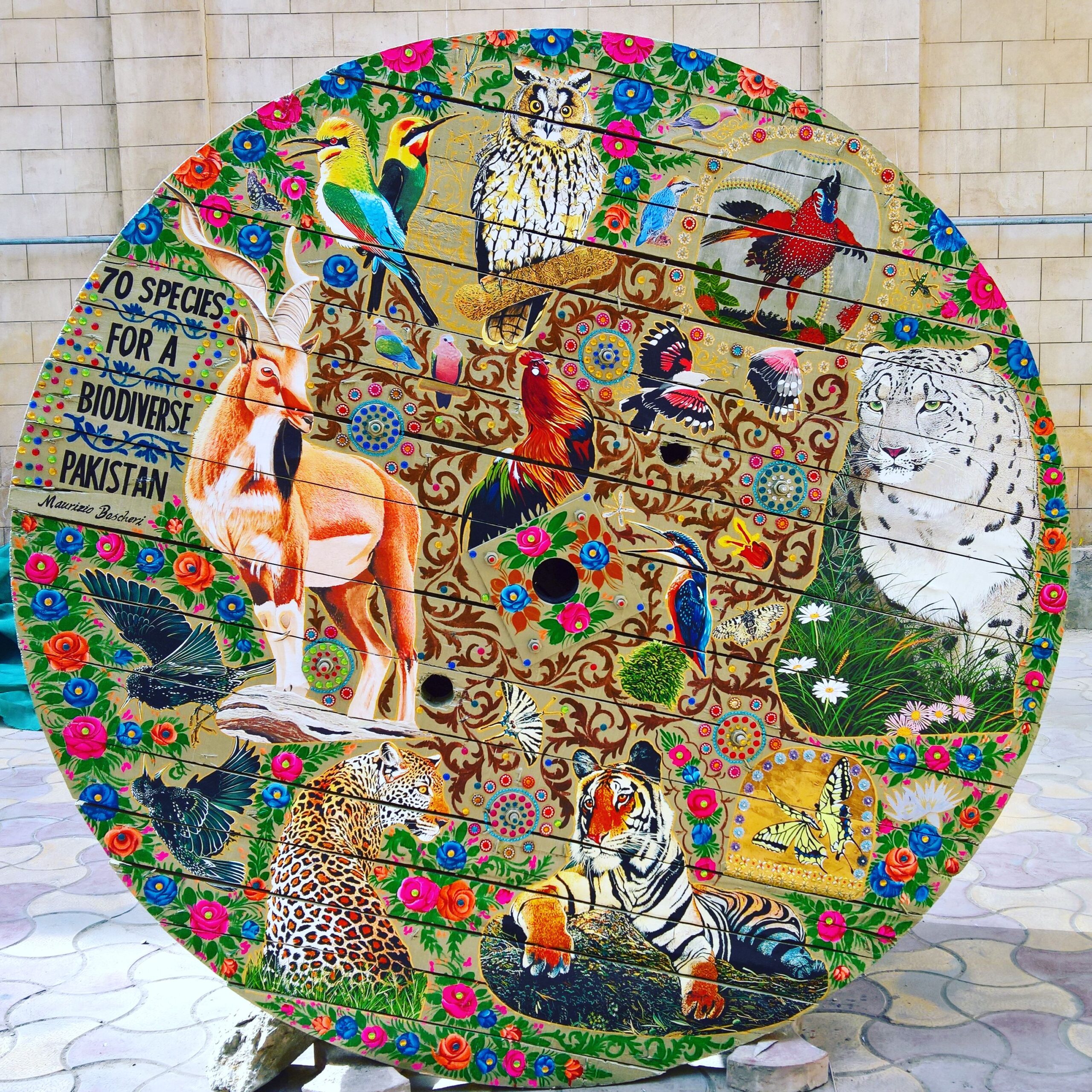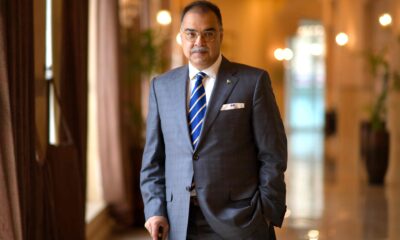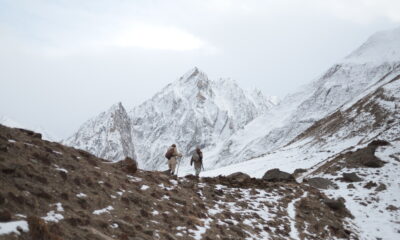Art
When Humdrum Becomes Exciting Art
A Public Outreach Project of the Karachi Biennale 2017.

Karachi’s citizens were in for a pleasant surprise when wooden cable reels became much more than mere spools to wind cables on!
Reel on Hai (‘The Reel is On’), a public art display of the first Karachi Biennale (KB) 2017 went into project mode from July 2016 to May 2017. Pakistan Cables, the country’s oldest cable manufacturer established in 1953, gave KB one hundred of its discarded reels to be installed as objet d’art in various public spaces. Many of us have dreamt that art would happen on every street corner of our cities, and projects such as I am Karachi’s ‘Wall of Peace’ and now ‘Reel on Hai’ are making this dream a reality.
Nilofur Farrukh, the Managing Trustee of the KB Trust says that KB plans ‘to give a new map of culture connectivity to one of the most popular urban centres of the world by creating synergy between art, the city and its people.”
The committee of the Public Outreach project of KB is chaired by artist Masuma Halai Khwaja. The selection of the designs was made through an open call, and the first few recycled re-creations of the cable reels by artists including painters, designers, ceramists, cartoonists, illustrators, and architects have been installed. Out of the fifteen reels completed so far, a few have been created by non-Pakistani artists as well.
The first reel was painted by Abdullah Ahmed Khan, better known as ‘Sanki King’. The reel has Urdu script written in sap green on a dark green background and is placed in the premises of the Orangi Pilot Project (OPP) office in Orangi Town. On one face of the reel’s disc is painted a couplet by Dr Akhtar Hameed Khan – the founder of the OPP: ‘Hazaron sheher basaeey hain badshaho nay, Abb aik sheher ghareebon ko bhi basaanay do’ (There are thousands of cities built by kings, let the poor populate a city). On the other side the reel he has quoted Abdul Sattar Edhi: Sirf alfaaz aur taweel duaen, Khuda ko mutassir nahin karteen; Apnay aamaal say apna eeman zahir karo.’ (words and prayers alone do not impress God; a show of well-meaning actions and deeds demonstrate your faith). The spine of the reels has sayings by architect Parveen Rehman, Director RTI, OPP, who was killed in March 2013, ending her almost three decade-long career of fighting for the land and basic rights for Pakistan’s poor.
The country’s celebrated cartoonist and painter Feira and his daughter Fakeha, painted the second reel with symbols of freedom and peace. The reel is installed at St. Patrick’s Cathedral in Saddar – the heart of the city.
Sahyra Qamer Sultan’s reel is located inside the Alliance Francaise. She has used paint and terracotta tablets to depict characters from famous South Asian folk tales. Her work has influences of the Persian and Pahadi miniature paintings, as well as from the artefacts of the ancient Indus Valley Civilisation.
Similar to the challenges of a grid for architectural design the visual artist working as an installation artist also faces the challenge to go beyond a direct visual narration of working on the canvas. Some of the installations fall short as they seem to ignore the dynamism that the reel – a three dimensional object offers, as well as its relationship in the space and the muhalla where it is installed.
Much like the first two reels painted by Sanki King and Feira and Fakeha, artists Tabinda Chinoy’s reel at IBA University Campus, Akhtar Zia’s at Fomma, Zamzama Park in DHA, Sana Burney’s at the Safari Park and Javeria Arshad’s reel ‘Ode to Edhi’ at the KMC Sports Complex are paintings/illustrations on all sides of the reels.
However, UK-based architect Wajiha Afsar deviates and puts on her architect’s cap to come up with ‘Jugnoo’ (firefly), whereby she deconstructs and re-uses three reels, placing her installation near the Casualty Ward of the Jinnah Post Graduate Medical Centre, providing the visiting of admitted children with relief and distraction as they can sit on inbuilt benches, read, climb, or play around the reel.
Italian wildlife artist Maurizio Boscheri has also participated in Reel on Hai. He has been to Karachi thrice in the last twelve months as an exhibition of his wildlife paintings was held at the Mohata Palace Museum last year –the first time that a foreign artist had a solo show there. His reel has been placed near the Custom’s House at the Eduljee Dinshaw Road attracting people to view the bio-diversity of Pakistan, as Boscheri has painted 70 fauna and flora from across the country. The number signifies the 70 years of this country’s existence. One could either chuckle at his inclusion of the tiger on the reel or feel sad as this predator, together with the lions, cheetahs and wolves that once ruled this land, have long been extinct from this region that is now Pakistan. Nevertheless, it is still a great teaching tool about the flora and fauna. Another Italian artist, Giuseppe Percivati’s reel is installed in the courtyard of Greenwich University. His work showcases two portraits that of a man and a woman on each disc.
Interdisciplinary German artist Johannes Gerard made his installation with two reels at the small sculpture park at the Indus Valley School of Art and Architecture in Clifton. It is a highly conceptual, minimalistic work using the reels in their original form, tied with rope. Perhaps this symbolises our society and its relationship with the cable industry.
In contrast to Gerard’s reels that are without any embellishment, an eye-candy reel kept in the foyer of the Beach Luxury Hotel is made by a group of Karachi women called the Piece-makers Guild. The reel has been titled ‘Heroines not Victims’, and it showcases strong and diverse women from different backgrounds on disc and Ralli-making women on the other with the sea behind them, literally also in the background as the hotel is located at the creek. While several colourful dupattas edged with silver and gold ‘gota’ and spools of colourful threads hang on the spine of the reel utilises the group’s applique and quilting forte with pieces of fabric – emcee the name ‘Piece-makers’.
Hasnain Ali’s reel is transformed into a tuck shop for a disabled vendor at The Civilizations School, which may act as a prototype for small business outlet.
Ceramist Bina Ali’s reel at the Safari Park is called ‘Ode to Karachi’. During the day the reel looks mundane with high-rise buildings painted against the sky, but come night-time and the lights on the reel that come on becoming a thrilling visual experience. It revives the reputation of Karachi, which uses to be called ‘The City of Lights’ at one time.
An interactive reel has been created by children’s furniture designer Zarine Ali. She has incorporated several additional and colourful items that are of recycled materials and has named the reel with its kinetic spinners and mirrors ‘Samandar ke Saaz’ (musical instruments of the sea). Children visiting the Hill Park would certainly be attracted to it. However, I am not sure about the long-term durability of all the materials exposed to the city’s sun and wind.
Nonetheless, one is hopeful that the reels will stay in the spaces designated for them, unlike ‘The Forgotten Text’ – a 40-ft high sculpture created in 2004, which went missing from the roundabout in Clifton, where it was installed. It was created by artist Amin Gulgee who is the curator of the Karachi Biennale 2017.
As more and more reels will be added in public spaces, they will not only become pieces of conversation for people, engaging them with these novel art-works, they will also help to impress upon them that our environment can be improved with the use of recycled materials.

-

 Business2 months ago
Business2 months agoZafar Masud: A Journey of Survival, Leadership and Purpose in Life
-

 Entertainment2 months ago
Entertainment2 months agoHundan: Touching the Core of Humanity
-

 Cover story2 months ago
Cover story2 months agoKinza Hashmi: Tapping Emotional Depth
-
Bright Side2 months ago
The Bright Side
-

 Business2 months ago
Business2 months agoA Roadmap to Pakistan’s Economic Revival
-

 Travel2 months ago
Travel2 months agoRevisiting Karachi’s Interesting Places
-
Ramp Act2 months ago
Ramp Act
-
In Tune2 months ago
Faakhir Mehmood – Music Embedded in the Soul



